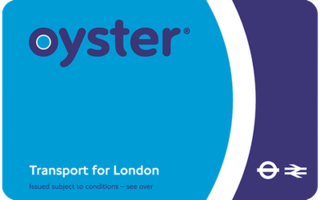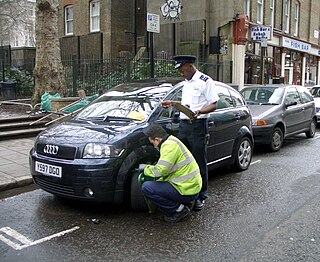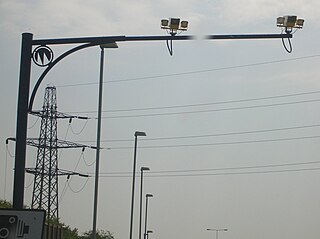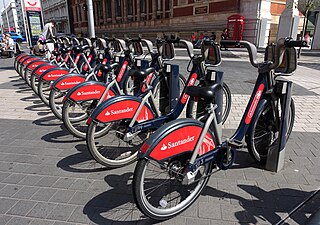Related Research Articles

Transport for London (TfL) is a local government body responsible for most of the transport network in London, England.

The London congestion charge is a fee charged on most cars and motor vehicles being driven within the Congestion Charge Zone (CCZ) in Central London between 7:00 am and 10:00 pm Monday through Friday, and between 12:00 noon and 6:00 pm Saturday and Sunday.

The Blackwall Tunnel is a pair of road tunnels underneath the River Thames in east London, England, linking the London Borough of Tower Hamlets with the Royal Borough of Greenwich, and part of the A102 road. The northern portal lies just south of the East India Dock Road (A13) in Blackwall; the southern entrances are just south of The O2 on the Greenwich Peninsula. The road is managed by Transport for London (TfL).

Road traffic safety refers to the methods and measures used to prevent road users from being killed or seriously injured. Typical road users include pedestrians, cyclists, motorists, vehicle passengers, horse riders, and passengers of on-road public transport.

The Oyster card is a payment method for public transport in London in the United Kingdom. A standard Oyster card is a blue credit-card-sized stored-value contactless smart card. It is promoted by Transport for London (TfL) and can be used on travel modes across London including London Buses, London Underground, the Docklands Light Railway (DLR), London Overground, Tramlink, some river boat services, and most National Rail services within the London fare zones. Since its introduction in June 2003, more than 86 million cards have been used.
Progress in the area of prevention is formulated in an environment of beliefs, called paradigms as can be seen in the next table. Some of them can be referred to as professional folklore, i.e. a widely supported set of beliefs with no real basis. For example, the “accident-prone driver” was a belief that was supported by the data in the sense that a small number of drivers do participate in a disproportionate number of accidents, it follows that the identification and removal of this drivers will reduce crashes. A more scientific analysis of the data indicate that this phenomenon can be explained simply by the random nature of the accidents, and not for a specific error-prone attitude of such drivers.
Vehicle Excise Duty (VED) is an annual tax that is levied as an excise duty and which must be paid for most types of powered vehicles which are to be used on public roads in the United Kingdom. Registered vehicles that are not being used or parked on public roads and which have been taxed since 31 January 1998, must be covered by a Statutory Off Road Notification (SORN) to avoid VED. In 2016, VED generated approximately £6 billion for the Exchequer.

A large goods vehicle (LGV), or heavy goods vehicle (HGV), in the European Union (EU) is any truck with a gross combination mass (GCM) of over 3,500 kg (7,716 lb). Sub-category N2 is used for vehicles between 3,500 kg and 12,000 kg (26,455 lb) and N3 for all goods vehicles over 12,000 kg as defined in Directive 2001/116/EC. The term medium goods vehicle is used within parts of the UK government to refer to goods vehicles of between 3,500 and 7,500 kg which according to the EU are also "large goods vehicles".

A truck driver is a person who earns a living as the driver of a truck, which is commonly defined as a large goods vehicle (LGV) or heavy goods vehicle (HGV).

Decriminalised parking enforcement (DPE) is the name given in the United Kingdom to the civil enforcement of car parking regulations, carried out by civil enforcement officers, operating on behalf of a local authority. The Road Traffic Act 1991 provided for the decriminalisation of parking-related contraventions committed within controlled parking zones (CPZ) administered by local councils across the UK. The CPZs under the control of the local councils are also referred to as yellow routes and they can be easily identified with yellow lines marked on the roads with relevant time plates. Councils employ parking attendants to enforce their CPZs directly.

London Overground is a suburban rail network serving London and its environs. Established in 2007 to take over Silverlink Metro routes, it now serves a large part of Greater London as well as the home county of Hertfordshire, with 112 stations on nine different routes.

London has an extensive and developed transport network which includes both private and public services. Journeys made by public transport systems account for 37% of London's journeys while private services accounted for 36% of journeys, walking 24% and cycling 2%. London's public transport network serves as the central hub for the United Kingdom in rail, air and road transport.
Truck classifications are typically based upon the maximum loaded weight of the truck, typically using the gross vehicle weight rating (GVWR) and sometimes also the gross trailer weight rating (GTWR), and can vary among jurisdictions.

The London Low Emission Zone (LEZ) is a traffic pollution charge scheme with the aim of reducing the exhaust gas emissions of diesel-powered vehicles in London. The scheme applies London-wide to commercial vehicles, and should not be confused with the Ultra Low Emission Zone (ULEZ), introduced in April 2019, which applies to all vehicles in Central London. Vehicles that do not conform to various emission standards are charged; the others may enter the controlled zone free of charge. The low emission zone started operating on 4 February 2008 with phased introduction of an increasingly stricter regime until 3 January 2012. The scheme is administered by the Transport for London executive agency within the Greater London Authority.

Cycling in London is a popular mode of transport and leisure activity within the capital city of the United Kingdom. Following a national decline in the 1960s of levels of utility cycling, cycling as a mode of everyday transport within London began a slow regrowth in the 1970s. This continued until the beginning of the 21st century, when levels began to increase significantly - during the period from 2000 to 2012, the number of daily journeys made by bicycle in Greater London doubled to 580,000. The growth in cycling can partly be attributed to the launch in 2010 by Transport for London (TfL) of a cycle hire system throughout the city's centre. By 2013, the scheme was attracting a monthly ridership of approximately 500,000, peaking at a million rides in July of that year. Health impact analyses have shown that London would benefit more from increased cycling and cycling infrastructure than other European cities.

Road speed limit enforcement in the United Kingdom is the action taken by appropriately empowered authorities to attempt to persuade road vehicle users to comply with the speed limits in force on the UK's roads. Methods used include those for detection and prosecution of contraventions such as roadside fixed speed cameras, average speed cameras, and police-operated LIDAR speed guns or older radar speed guns. Vehicle activated signs and Community Speed Watch schemes are used to encourage compliance. Some classes of vehicles are fitted with speed limiters and intelligent speed adaptation is being trialled in some places on a voluntary basis.

Santander Cycles is a public bicycle hire scheme in London in the United Kingdom. The scheme's bicycles are popularly known as Boris Bikes, after Boris Johnson who was Mayor of London when the scheme began operating.

The Bus Safety Act 2009 is a law enacted by the Parliament of the State of Victoria, Australia and is the prime statute regulating the safety of bus operations in Victoria. The Act was developed as part of the Transport Legislation Review conducted by the Department of Transport between 2004 and 2010 and is aimed at preventing deaths and injuries arising from bus operations in Victoria and establishes a modern "best practice" regulatory framework to assist in maintaining and improving the Victorian bus industry's good safety record.

The Ultra Low Emission Zone (ULEZ) is an area in London where a fee is charged for driving the most polluting vehicles. Plans were laid out under Boris Johnson and introduced by Sadiq Khan in April 2019 in Central London, covering the same area as the congestion charge. It caused the number of the worst polluting vehicles to drop from 35,600 to 23,000 and a 20% reduction in emissions in Central London in the four months following its introduction.
References
- ↑ Jupp, Ethan. "London's Direct Vision Standard for HGVs to tackle truck visibility 'crisis'". Motoring Research. Retrieved 17 December 2019.
- 1 2 "Direct Vision Standard and HGV Safety Permit". Transport for London.
- ↑ "Direct Vision Standards" (PDF).
- ↑ "Direct Vision Standard (DVS): Frequently asked questions" (PDF).
- ↑ "TfL's Direct Vision Standard is flawed say associations; as latest change places burden on hauliers' shoulders". www.commercialmotor.com. 22 March 2018.